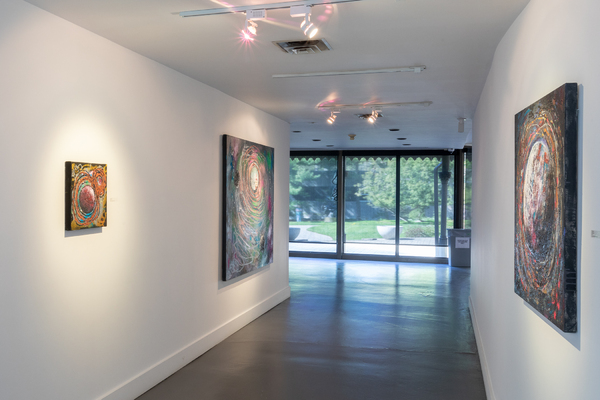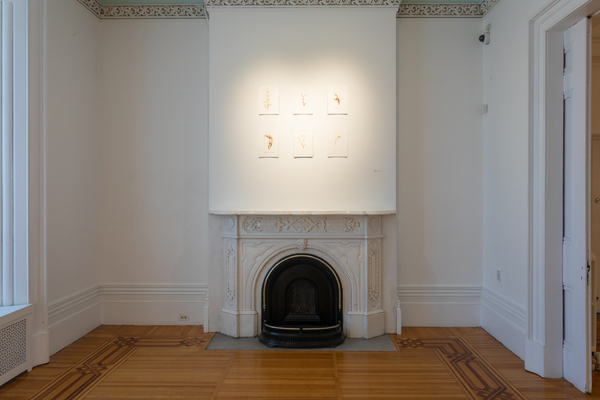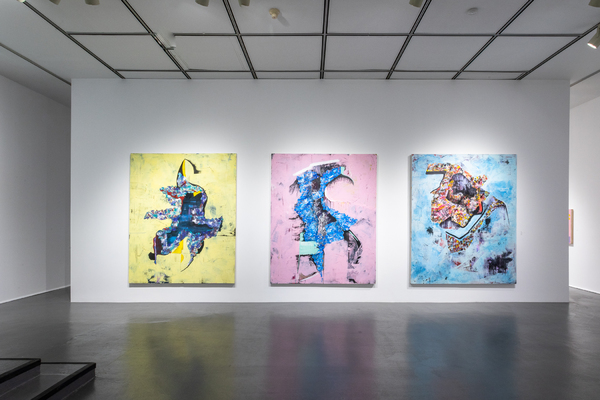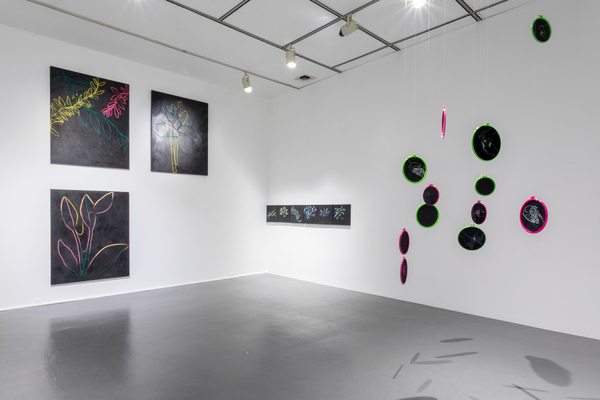Artist Statements
Renz Baluyot
My art mainly focuses on a love for homoerotic combined with the game Dungeons and Dragons. These two subjects present my characters in colourful pin ups, all of them serving the hypersexualized and homoerotic ideals of the male body within a fantasy world. This is a way to express my queerness, one where I cannot express within my traditional Christian family. I get my inspirations from artists such as Tom of Finland (Touko Laaksonen), Patrick Fillion, Gengoroh Tagame, and Robert Mapplethorpe – all who focus on homoeroticism and the hyper sexualization of gay men and their bodies. Overall, my works’ purpose is to have a fun, gay, sexy time with all these well-endowed fantasy men.
For this exhibition, I wanted to continue this path and turn it into a graphic advertisement-like painting, where my characters are posing as poster boys of certain Dungeons and Dragons branded items but with a silly, homoerotic twist to them. I based four of the five larger paintings on products that have sexual innuendos pertaining to semen and the penis and for the others, I went for my usual pin-up style, focusing on their larger-than-life bodies and present a little personality. I like to undress my characters and put them in these stylized and seemingly-too-small athletic wear and lingerie paired with vibrant, funky, and colourful backgrounds.
Brianne Casey
My vision of the world sees the rabbit hole of life as sequences of events that we have no control over. The hopelessness and darkness fulfill our existence as we attempt to grab onto something and never let go. What we grab onto can either destroy, help, or make our lives more durable. The year was 2020 and environmental injustices are ravaging the planet. Leaders are incapable of setting the chain reaction for society towards a healthier future, and we are the ones who carry the strength. Despite the best efforts from the people who wished for change, we lost the battle. One by one we succumb to death and despair; the apocalypse is upon us, a pandemic struck and thus killing thousands. In a near future, we now rebuild ecosystems and regain the independence that humans once had but there is a new being at the top of the food chain. Known as the Creationists, they are gathering materials to emulate what Earth was like before. What does it mean to be human? What does love, loss and sorrow feel like? When the world ends, who are you taking hold of as you desperately try to protect those who you care for? Walking amongst the debris of a distance path, the Creationists come and re-create what once was in a sculptural attempt of bringing back their ancestors. The gruesome reality of their own doing comes back to life and is put up as a reminder that they cannot walk the same path that we did. Toxicity will engulf their souls and rip out every ounce of hope they once had and now with a fresh start to life and a new evolutionary trail, they are the ones re-writing the future as we have failed as a species to save ourselves from the impending doom. However, amongst the heartache and the harsh realities that we face presently, the future is bright and full of hope. Activism is taking over our planet like a pandemic and we are being infected with hope. Humans are a resilient species and as a creationist, I wanted to come back to the past to let you know that your story lives on and that the path that once was set in stone has been rewritten.
Aidan Frenette
Over the course of the past year I have used my time to research, explore, and visually render essential elements of the canal system. I have created a variety of pieces that are each relevant to the subject matter in a different way. For example, the first realistic graphite boat drawing referenced early boat photography while also accurately depicting the cold, removed nature of the ship itself. In my natural pigment pieces, I removed any trace of constructs, and through the display of local canal flora and fauna I focused on the often overlooked ‘natural’ beauty of the area. My lumen prints juxtapose the unfeeling nature of a tanker and the bubble-gum pink, hyper-saturated aesthetic of the medium, resulting in engaging obscurity.
In further developing this body of work, I began cementing crucial concepts formed within first semester, like experimental photography. This can be seen within my emulsion lift tiles created from resin and my own photographs of boat-related areas. Finally, I created several distorted photographs from images I took earlier in the year. Using mechanical alteration, the images became obscured and graphically interesting. Finally, I suspended an emulsion lift in a block of resin to engage with the pre-existing resin tiles made in the first half of second semester. The body of work intends to showcase the delicate nature of a vastly mechanical network of commerce.
Rea Kelly
My art practise is rooted in exploring and experimenting with the portraiture genre. I am interested in how humans and emotions are portrayed in portraits; how the human face can be challenged to reveal something beyond a superficial understanding of facial features. Through my work, I use the human face and form to understand one’s identity and visually express the more unflattering natures of the experience of human emotion.
My process of working is intuitive. I do not aim to fully represent or fully abstract the image, and instead operate in between representation and abstraction. The result of my rendering of faces is not to capture an exact likeness, but to produce a psychological emotion using the face as a point of reference. I hope to capture a feeling of unease, unsettledness, and even the uncanny. These faces could sit uncomfortable for the viewer while I work to show the “internal” on the “external”. These portraits are not about the likeness and features but about the internal conflicts we experience as human beings. I explore this idea through the distortion of my subjects’ face. It is an intentional and unrefined look, mirroring the messiness and unpredictability of emotions. I favour bold and harsh colours using layers of paint and densely applied oil bar. With an expanding history of portrait painting behind me, I question how I can use the genre of portraiture to not necessarily flatter the subject, but to use the face and figure as a vessel for depicting the more uglier, painful, and even humorous internal experiences. The psychology of the figure takes precedence over any kind of accurate visual representation, as I challenge the viewer’s pre-conceived notions of what portraiture is and what it could mean.
James Kershaw
Originally from Niagara Falls, Canada, I was born in 1946 to conservative Baptist white parents. As a teen, I would sit on the church's back seat on Sundays, feeling a warm breeze from the open window behind me. Looking out, I'd see school buddies cycle by with their fishing rods draped over handlebars on the way to Chippawa. Almost mute, I moved to Toronto at twenty-one. It took me over ten years to get comfortable with changing environments. Starting to attend life drawing groups at various locations, using multiple marking methods to define form, offered me a sense of place and presence. Persistence nurtured a feeling of being anchored in something bigger than me. I discovered the human form presented a foundation for my painting and drawing. An introduction to hand-lettering at a community college continued to thirty years of employment in display advertising. Through experience, I found my voice and surprisingly, businesses profited from my services. My present work reflects the personal crisis of a global pandemic and global warming's imprint on humanity in the immediate state, including nature's role. I direct readers to Jailhouse (2020) and Eternity (2021). Valuing mentorship with tips on observing, I relish rare opportunities to paint others who are not posing. I remember the recent past sitting on a comfortable sofa taking in the life of shoppers who passed the day in the mall. Saving their expressions and gestures in my sketchbook was my art. Drawing from life helps me locate a language once held from me but has emerged clear and robust. Furthermore, painting and drawing are a release and shape my future.
Rachel McCartney
I am weightless as I float in an endless sea. My pulse lowers as the coolness of the water gently brushes my hair. The sounds of the world fade away as sink deeper into the void and it is here that I find true peace. I am in my safe space. Nothing exists except for the sounds of my conscious. Here, I am left with my thoughts, I process my emotions, and decompress as I let go of life. Here, I become transcendent from myself.
Water is transcendent. In eastern philosophy, oceanic imagery is continuously used to teach about the cyclical nature of life, and its all-encompassing emotions. We are all waves, different from the larger body of the ocean but not separate from it. We flow through life on our intended course, our wave crests and crashes, then recedes back into the sea, and the cycle starts again. It is always constant, though we are not, and through this we must come to embrace and find peace in the dependency and cycle of the wave. Upon diving into the concept of water, and through reflecting on its significance to me I have come to discover these three truths.
Water is often the site for internal conflict. Often personified as an emotional being, I find I seek out water when I myself am drowning in a wave of emotions. It acts like a support to see my own feelings reflected in the swirling chaos before me. This kinship of energy is strengthening.
Water is associated with hope. The distant horizon line serves as a reminder to the world of possibilities before me. A sea of currents readily available to sweep me in any which direction. It is all consuming and overwhelming, but each passing wave strengthens my ability to trust the process. For now, all I can acknowledge is the existence of that hope, and its ability to manifest itself as however I choose in the future.
Lastly, water is congruent with change. From a scientific perspective water exists in our world in multiple forms and is in a constant cycle of change. Humans, consisting of mostly water, share a commonality with water as they are ever-changing. This is why water creates deeply resonating imagery in media that speaks to change, and therefore is an appropriate choice in subject matter given the whirlwind of events over the course of the past year. There is no need for me to discuss the global events, for those who were there already understand. From a personal standpoint however, at this point in my life I am experiencing a great period of change, full of endless possibilities and endless conflicts. At this point in time, I am the ocean, finding my wave.
Jess McClelland
Comics and cartoons have always played a pivotal role in my life. Even from a young age, I perceived comics as a worthy and important means of communicating my thoughts with others. It is a medium that has great potential for clear communication between the artist and the reader. In comics, I see a careful balancing act between text and image that offers artists great freedom in clear dialogue. It presents its own language and vocabulary that is easy to grasp through its own iconography. In careful consideration of the relationship between comic books and the realm of fine art, I seek to bridge the gap between these seemingly distant worlds through my own artistic practices. I experiment and analyze specific elements and trademarks of the comic book medium, including the ‘vocabulary’ of comics and the ways in which comics are framed. In my exploration of comic book vocabulary and styles, my body of work has helped me connect comics to the gallery space in thought provoking ways. The relationship of text and image offers unique control to interact with the art at the viewers’ own pace. In Dreams (2020), is a six-page comic narrative that provides a humorous glimpse into a multi layered dream scenario, exploring strange encounters and unique characters. In comic books and cartoons, dreams are a distortion of all that we know. The piece is narrated through my own inner dialogue, providing commentary on the unusual circumstances of my dream. My work provides a glimpse into an abstraction of reality and how I perceive elements of daily life through the lens of comics and cartoons. A great cartoon can simplify but enhance elements of daily life. In Dreams has elements of a strange nightmare that explores how cartoons can frighten viewers in their distortion, an example in how I believe comics offer experimentation in making complex work. The intent of my practise and work shows cartooning as both a fine art and form of intimate communication with a viewer.
Lillian Pasqua
The background of my art practise is found in interdisciplinary explorations in illustration, fashion design, and pattern drafting. This body of work features various elements of the natural world superimposed onto hand-draped and sewn garments. Having a history with uniformed schools and workplaces, I came to appreciate the pristine white of a dress shirt as a blank canvas rather than a restriction of creativity. By layering designs onto clothing that is typically worn without embellishments and in a uniform-like fashion, I hope to create a sense of juxtaposition.
I use embroidery because its impermanent nature allows me to create and alter any design, I see fit. Conceptually, I am also drawn to embroidery because it represents the ephemerality of much of the subjects of my designs. The threads are delicate and will eventually be undone, much like how the flowers, animals, and body parts they depict are surrounded in impermanence. In addition to embroidery, I also incorporate the use of screen printing to superimpose natural and botanical imagery onto my work. These pieces represent a compromise between the concept of uniformity and creativity, as well as a compromise between two artistic practices. With this body of work, I aim to discover the boundaries between these two things.
Kira Pretty
Unfulfilled Desires is a collection of interior photographs taken at the artists’ family home. This body of work explores the concept of human longing as a desire for well-being alongside the role of family and its relation to the multidimensional aspects of home.
Mental illness generates a continued longing for security—a burning desire for consistent happiness and comfort throughout life. Human longing presents as both beneficial and detrimental to one’s own mental health in the form of hope and hopelessness. Happiness is not a static state, but rather an intricate melody of emotions that ties in the yearning and longing aspects of happiness, such as crying tears of joy, or the sensation of missing someone before they have left.
Home is a safe place—a place of rest, comfort, and happiness—a break from the confinements of mental illness.
Home extends beyond just the physical walls of a house, similar to how family extends beyond the borders of biology into the realm of one’s chosen family, made up of close friends, significant others, and four-legged companions. Family dynamics play a crucial role in defining home, and how the presence of family, or lack thereof, determines one’s happiness and outlook on life. As material items come and go, home will always have a permanent presence in one’s life through the form of family.
Through this body of work, the artist attempts to challenge the traditional definitions of home, family, and well-being, and re-work them into something that is both tangible and conceptual.
Curt Richard
When trying to make a mark in the art world, it's always good practice to try to do something that is different than all the others. That is what separates one artist from another, it is the ability to create individually distinct works of art.
The idea for this series of work was to form a visual impression of the reaction to music. Each piece is based on how the effect of listening to complete discographies of particular rock bands had on the artist, and each piece is titled to allude to which band was used. The use of traditional and non-traditional tools as advocates for marks is based on how each song made the artist react, and the resulting different layers and textures is the artist's way of conveying a cathartic and subconscious self portrait of the metaphysical self.
Kaitlyn Roberts
Dark Water is a throat clenching. It’s that weird gross ball of build-up that won’t go away no matter how many times you swallow. Dark Water is one. two. three. four. five. six. Dark Water is waking up in the morning and still not being able to see what you’re doing. But you’re moving anyway. It’s going to three different jobs in one day and then coming home to do more work and not remembering doing any of it. It’s moving so fast that you don’t have time to think. There is something that happens to the mind when you’re wet. The body begins to have control again, letting the anxiety fall into the background. The hot steam shifts me as I become aware of every molecule of condensation. It’s a reset. My mind is clear again. It is vulnerable and yet it is empowered.
Taylor Sorensen
All year I had to listen to "Imagine being alone" during this pandemic.
And of course, artists are dealing with "what is art during a pandemic" or "what will it be after."
This past year I was barely living, let alone being creative. In expressing that "my mental health was bad" and finding myself dismissed, I should have found my stresses and anxieties avoidable. Handling life and figuring out how to continue living while being stuck in a routine was a battle with disappointment.
The art I have made no longer exists, like how Agnes Martin would tear up her art if she didn't like it. No reworking it, just in the trash. I tore my art up, the paper, wood panels, canvases and stretchers. Art only means something to the artist; and to me there is no importance in my work. The “perfect” artwork worth millions could bring me fame, and I wouldn't hesitate to tear it to shreds if it came with a bad memory.
I had no art-making process this year. This is no statement of the art I made and will make.
This is simply a goodbye.
Chardon Trimble-Kirk
My art explores contrasts of light and darkness, joy and depression and femininity and masculinity found in negative space and chaotic mark making. In my practise I reflect on my thoughts, interests and fears. Exploring this through my materials is an integral aspect of my work that holds deeply personal and intentional meanings. I intend to show these contrasts co-existing, shown in my work Vibrancy, Intimacy and Growth. Vibrancy explores my love of botanical life, serving as a metaphor to the strength it takes to overcome darkness and depression to find joy in the natural world. Through the variety of bold and surreal colours, I take the beauty of the natural world and create an image that becomes a fantasy. The plants glow with vibrant hues and rich oil colours, contrasting with the darkness creeping around it. Intimacy is an installation of embroidery that explores healing and being gentle with ones’ self. I choose the traditional practise of embroidery to reference femininity and reflect on my own struggle with finding my place in the world. Intimacy re-introduces the motif of the darkness, depicting empty space as an ever-present void. Growth speaks to the contrast of femininity and masculinity through my material. Using rope as an inherently masculine material, I bend and form the rope into organic curves of feminine botanical shapes. Alongside the contrast of masculinity and femininity is the darkness and light, which in this piece act as oil and water. The darkness of the canvas and brightness of the rope do not mix except for a few messy moments within the piece. The work is highly literal while also depicting my personal growth and strength fighting against the darkness, with the ropes acting as a metaphor for my newfound strength and flexibility.
Zach White
Blast Off is a series that invites the viewer to my personal world of characters spiralling in an environment surrounded in bright colour and intricate patterns. My five-year journey as a student artist has culminated into building a unique style and subject matter that is undefined by any specific movement or style of art. My practise references my influences of art movements and styles I continue to deploy in my work. I use styles such as stippling, cross hatching and loose line that reference my original interest in realistic styles of art. Vibrant colours pull the viewer as an homage to post-impressionists, where I learned that colour choice can breathe emotion into artwork. Layering and patterns is something I explored when I dove into spray paint and graffiti street art where intricate line and perspective exist simultaneously. My subject matter is born out of the concept of photography, when the scientific and artistic communities came together to create the camera. In this invention, many people once believed that practises of art like drawing and painting would succumb to the ease of the perfect capture of a photograph. However, these mediums persisted because artists learned that art does not need to replicate life, but rather show life through the eyes of the artist. These pieces work to convey a cacophony of emotions and ideas that are constantly moving throughout my own head. During the creation of this series I suffered a few concussions playing sports and although they made it difficult to focus my attention on one specific idea, they forced me to create by bouncing from one thought to the next and ultimately leading to the universe of fractured characters and altered perspectives that embodies this series of work.







